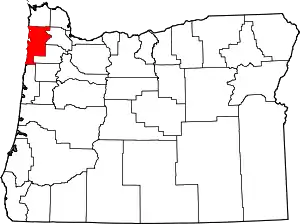Pacific City, Oregon
Pacific City is a census-designated place (CDP) and unincorporated community in Tillamook County, Oregon, United States.[5] The population was 1,109 at the 2020 census. Pacific City is home to the Cape Kiwanda State Natural Area.
Pacific City, Oregon | |
|---|---|
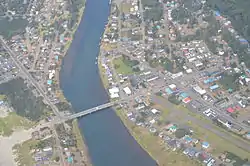 Aerial view of Pacific City | |
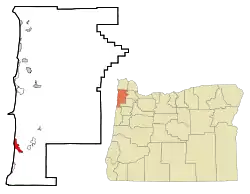 Location of Pacific City, Oregon | |
| Coordinates: 45°12′N 123°58′W | |
| Country | United States |
| State | Oregon |
| County | Tillamook |
| Area | |
| • Total | 3.83 sq mi (9.91 km2) |
| • Land | 3.72 sq mi (9.63 km2) |
| • Water | 0.11 sq mi (0.28 km2) |
| Elevation | 13 ft (4 m) |
| Population | |
| • Total | 1,109 |
| • Density | 298.28/sq mi (115.15/km2) |
| Time zone | UTC-8 (Pacific (PST)) |
| • Summer (DST) | UTC-7 (PDT) |
| ZIP Code | 97135 |
| Area code | 503 |
| FIPS code | 41-56150[3] |
| GNIS feature ID | 1136609[4] |
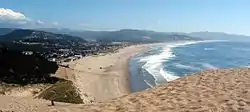
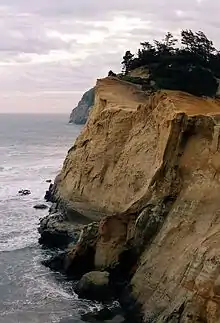
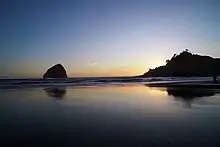
History
In 1845, Mr. Johnson, a cook on an English ship sailing along the Columbia River, deserted and traveled down the Willamette Valley. Establishing a land claim in Champoeg, he began removing brush and that summer set off a burn to clear debris. The Champoeg Fire got out of control and spread eastward. Unfortunately, the wind then reversed direction and strengthened, blowing the blaze around the previous burn and fanning it into the dry Coast Range, where it burned in the Yamhill basin for weeks, consuming 1,500,000 acres (6,100 km2) of old growth forest – the largest such area destroyed in a single forest fire in the United States.[6] Settlers did not live west of the Coast Range, but the small tribes of Native Americans in the area, already depleted by 80% due to malaria and other epidemics from 1830 to 1841,[7] were driven from their lands.
The Nestuggas were one such tribe, that had previously been encamped just north of Pacific City near the town of Woods. They had noticed the smoke for several weeks, but were surprised one morning as the bright flames flickered atop the crests of the surrounding hills and rushed down on them. The Nestuggas fled by canoe down the Big Nestucca River to the ocean, and took refuge on the half-mile wide bare sandspit between Nestucca Bay and the ocean. After several weeks the fires were ended by a heavy rain, but the devastation had been complete: the forests were gone, and the game found to be charred crisp or cooked in the water they had sought refuge in.[8]
Nestucca Bay was a rich fishing area, allowing the Nestuggas to survive despite the destruction of game. However, in 1854, settlers began arriving in the Tillamook Valley, and by 1876 Chief Nestugga Bill and the 200 remaining people of the small tribe were relocated to a reservation on the Salmon and Siletz River.
Many early pioneers arrived via seagoing steamers, others arrived from across the mountains. The town of Woods established itself as a depot for the new arrivals and a source of supplies and trade for the settlers. In 1886 the Linewebber and Brown cannery was started to take advantage of the plentiful fish in Nestucca Bay, shipping 12,000 cans of salmon a year and providing an economic basis for the region until 1926, along with logging and dairy farming. The area also became a "vacation" destination for Oregon Trail pioneers from the Midwest, who had never seen the ocean.
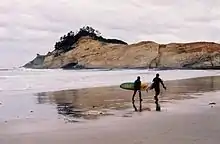
In 1893, Thomas Malaney platted the town of Ocean Park (now Pacific City) directly across the river from Woods. When a flood in 1894 wiped out the first lots, Malaney moved the town south to higher ground. The Sea View hotel (later renamed Edmundes Hotel) was built around 1895 to serve vacationers from the Willamette Valley. Other buildings and campgrounds were established for visitors, and Ferry Street was "paved" with wooden planks for automobiles.
The town gained its modern name of Pacific City in 1909 to avoid confusion with the Washington town of Ocean Park. By 1926, overfishing from gillnetting had left the bay depleted of salmon, so commercial harvesting was stopped and fishermen switched to surf-launched dories; over time, due to commercial fishing vessels, the Dory Fleet dwindled and today only a few recreational fishermen keep the tradition alive. In the 1920s, tourism became the mainstay of the economy, lasting until the Great Depression of the 1930s. An airport was built to attract barnstormers and aviators, and other roads and bridges were opened.[9]
Geography and climate
Pacific City is located along the Pacific Ocean adjacent to Bob Straub State Park and spans the Nestucca River with about half the city's area being behind Nestucca Bay. It is part of the Oregon Coast.
According to the United States Census Bureau, the CDP has a total area of 3.8 square miles (9.8 km2), of which 3.7 square miles (9.6 km2) of it is land and 0.1 square miles (0.26 km2) of it (2.86%) is water. The area is located 13 feet (4.0 m) above sea-level.[5]
| Climate data for Pacific City, Oregon | |||||||||||||
|---|---|---|---|---|---|---|---|---|---|---|---|---|---|
| Month | Jan | Feb | Mar | Apr | May | Jun | Jul | Aug | Sep | Oct | Nov | Dec | Year |
| Record high °F (°C) | 75 (24) |
79 (26) |
80 (27) |
89 (32) |
99 (37) |
99 (37) |
102 (39) |
106 (41) |
98 (37) |
94 (34) |
80 (27) |
71 (22) |
106 (41) |
| Average high °F (°C) | 49.8 (9.9) |
52.2 (11.2) |
54.7 (12.6) |
57.6 (14.2) |
62.0 (16.7) |
65.4 (18.6) |
69.7 (20.9) |
70.6 (21.4) |
69.3 (20.7) |
62.0 (16.7) |
53.3 (11.8) |
48.6 (9.2) |
59.6 (15.3) |
| Average low °F (°C) | 38.9 (3.8) |
38.7 (3.7) |
39.6 (4.2) |
41.3 (5.2) |
44.9 (7.2) |
48.7 (9.3) |
50.8 (10.4) |
51.2 (10.7) |
48.7 (9.3) |
44.9 (7.2) |
41.3 (5.2) |
38.0 (3.3) |
43.9 (6.6) |
| Record low °F (°C) | 8 (−13) |
11 (−12) |
25 (−4) |
28 (−2) |
30 (−1) |
33 (1) |
36 (2) |
36 (2) |
33 (1) |
19 (−7) |
17 (−8) |
9 (−13) |
8 (−13) |
| Average precipitation inches (mm) | 11.28 (287) |
8.90 (226) |
8.51 (216) |
5.60 (142) |
4.30 (109) |
3.03 (77) |
1.40 (36) |
1.38 (35) |
3.33 (85) |
5.89 (150) |
11.87 (301) |
11.83 (300) |
77.32 (1,964) |
| Average snowfall inches (cm) | 0.4 (1.0) |
0.3 (0.76) |
0.2 (0.51) |
0.1 (0.25) |
0 (0) |
0 (0) |
0 (0) |
0 (0) |
0 (0) |
0 (0) |
0.1 (0.25) |
0.3 (0.76) |
1.4 (3.6) |
| Source 1: Rainfall averages — PlantMaps[10] | |||||||||||||
| Source 2: Temperature averages — BestPlaces.net[11] | |||||||||||||
Demographics
| Census | Pop. | Note | %± |
|---|---|---|---|
| 2020 | 1,109 | — | |
| U.S. Decennial Census[12][2] | |||
As of the census[3] of 2000, there were 1,027 people, 485 households, and 317 families residing in the CDP. The population density was 274.7 inhabitants per square mile (106.1/km2). There were 1,090 housing units at an average density of 291.6 per square mile (112.6/km2). The racial makeup of the CDP was 94.16% Caucasian, 1.75% Native American, 0.58% Asian, 2.04% from other races, and 1.46% from two or more races. Hispanic or Latino of any race were 3.02% of the population.
There were 485 households, out of which 13.4% had children under the age of 18 living with them, 54.8% were married couples living together, 6.6% had a female householder with no husband present, and 34.6% were non-families. 30.1% of all households were made up of individuals, and 14.8% had someone living alone who was 65 years of age or older. The average household size was 2.12 and the average family size was 2.55.
In the CDP, the population was spread out, with 16.1% under the age of 18, 4.0% from 18 to 24, 17.6% from 25 to 44, 35.0% from 45 to 64, and 27.4% who were 65 years of age or older. The median age was 53 years. For every 100 females, there were 96.7 males. For every 100 females age 18 and over, there were 94.1 males.
The median income for a household in the CDP was $33,250, and the median income for a family was $55,368. Males had a median income of $26,042 versus $26,250 for females. The per capita income for the CDP was $25,819. About 8.4% of families and 7.9% of the population were below the poverty line, including 23.8% of those under age 18 and none of those age 65 or over.
Infrastructure
The shore station for the National Science Foundation's Ocean Observatories Initiative Regional Scale Nodes underwater cabled observatory is located in Pacific City.
Telecommunications undersea cables
Four undersea telecommunications cables come ashore in Pacific City:[13][14][15]
- Hawaiki Cable, which connects Pacific City and Los Angeles with Polynesian ashore sites in Kapolei, Tafuna, Mangawhai Heads,[16] and Sydney.[17]
- New Cross Pacific (NCP) Cable System, which connects Pacific City with East Asia ashore sites in Toucheng, Pusan, Nanhui, Maruyama, Lingang, and Chongming.[18]
Transportation
Pacific City is located 2.8 miles (4.5 km) from U.S. Route 101 and is served by the 1,875-foot-long (572 m) Pacific City State Airport, owned and maintained by Oregon Department of Aviation.[19]
Tillamook County Transportation District, with two bus stops in Pacific City, offers bus service to Tillamook.
References
- "ArcGIS REST Services Directory". United States Census Bureau. Retrieved October 12, 2022.
- "Census Population API". United States Census Bureau. Retrieved October 12, 2022.
- "U.S. Census website". United States Census Bureau. Retrieved January 31, 2008.
- "US Board on Geographic Names". United States Geological Survey. October 25, 2007. Retrieved January 31, 2008.
- "Pacific City". Geographic Names Information System. United States Geological Survey, United States Department of the Interior. November 28, 1980. Retrieved January 11, 2010.
- Salt Creek Watershed Assessment, Dec 2001 (PDF)
- "History of the Northwest Oregon State Forests" Archived 2006-09-23 at the Wayback Machine (PDF)
- The Great Forest Fire of 1845, Compiled by Leonard Whitmore, Siuslaw National Forest, Hebo Ranger District, 1986
- Pacific City History
- "Zipcode 97135". www.plantmaps.com. Retrieved July 24, 2021.
- "Climate in Pacific City, Oregon". www.bestplaces.net. Retrieved December 7, 2021.
- "Census of Population and Housing". Census.gov. Retrieved June 4, 2016.
- "Facebook riles tiny Oregon town with plan for undersea cable". Honolulu Star-Advertiser. Associated Press. January 9, 2020. Archived from the original on January 10, 2020. Retrieved January 9, 2020.
- "Trans-Pacific Submarine Cable Systems". Submarine Cable Networks. Retrieved January 9, 2020.
- "Interactive map of undersea cable networks worldwide". fiberatlantic.com. Retrieved January 9, 2020.
- Qiu, Winston (September 30, 2020). "Mangawhai Heads Cable Landing Station". Submarine Cable Networks. Retrieved March 23, 2021.
- "Hawaiki". fiberatlantic.com. Retrieved January 9, 2020.
- "New Cross Pacific (NCP) Cable System". fiberatlantic.com. Retrieved January 9, 2020.
- Oregon Department of Aviation Archived 2005-08-17 at the Wayback Machine
External links
- Pacific City Dory Builder Video produced by Oregon Field Guide
